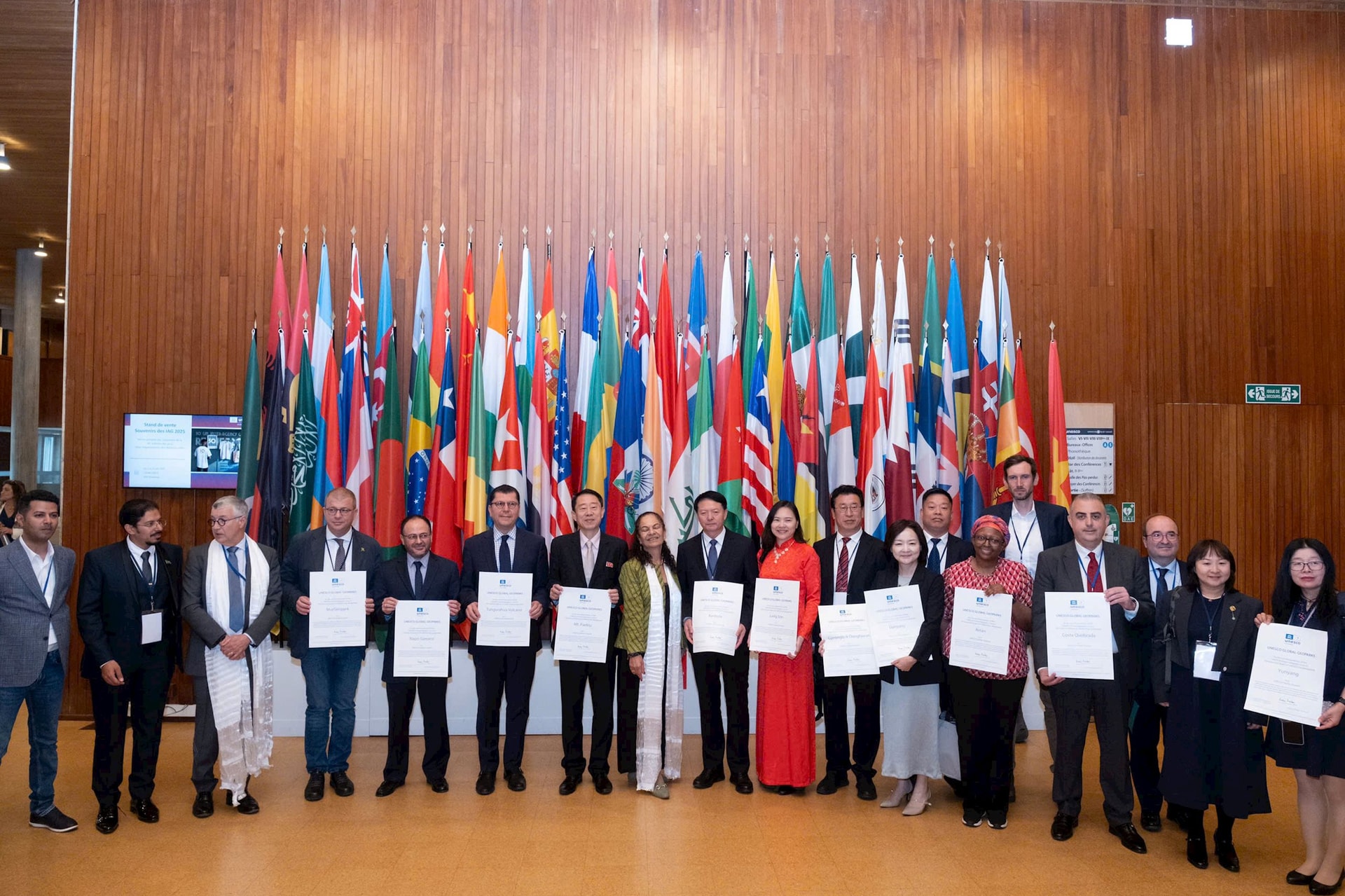Promoting geological heritage values – a launchpad for Lang Son tourism
The UNESCO Global Geopark designation for Lang Son is a prestigious title, offering a strategic opportunity for the province to position itself on the international tourism map and serve as a launchpad for attracting sustainable tourism investment.

The UNESCO Global Geopark designation for Lang Son is a prestigious title, offering a strategic opportunity for the province to position itself on the international tourism map and serve as a launchpad for attracting sustainable tourism investment.
Located in northeastern Vietnam, the UNESCO Global Geopark of Lang Son spans nearly 4,900 km². Under the theme "The Flow of Life in a Sacred Land," the park encompasses diverse geological, scenic, and cultural values, forming a “living natural museum” that has been internationally recognized. UNESCO officially announced its designation in April 2025 and presented the certificate on June 2, 2025.
On June 2, at the headquarters of the United Nations Educational, Scientific and Cultural Organization (UNESCO) in Paris, France, Lang Son Geopark was officially awarded the UNESCO Global Geopark certificate.
A Site of International Value
Lang Son is home to 24 geological formations, including 15 that were identified for the first time in Vietnam. Numerous remnants of ancient underground rivers and limestone cave systems—such as Tham Khoach, Doi Cave, and Lac Cave—attest to hundreds of millions of years of Earth’s geological evolution. The park also features distinctive fossil records and dramatic mountain landscapes interwoven with pristine vegetation.
Beyond its geological significance, Lang Son is a land rich in historical and cultural heritage. Archaeological sites like Tham Khuyen–Tham Hai, Keo Leng, Gio Cave, and the Nhi–Tam Thanh cave complex contain evidence of ancient Vietnamese habitation dating back tens of thousands of years. Prominent spiritual sites such as Bac Le Temple, Tam Thanh Pagoda, Dong Dang Mother Temple, and Thoai Mother Temple are closely tied to Mother Goddess worship—a recognized intangible cultural heritage of humanity.
The UNESCO Global Geopark of Lang Son comprises 38 tourist attractions, divided into four themed routes: "Exploring the Highlands’ World," "Journey to the Divine Realm," "Rustic Life on Earth," and "Path to the Water World." These form an experiential tourism ecosystem that integrates education and leisure, expanding opportunities to attract both domestic and international visitors and investors.
According to Mr. Nguyen Dang An, Director of the Lang Son Department of Culture, Sports and Tourism, the UNESCO Global Geopark designation provides a breakthrough for Lang Son to develop tourism alongside heritage conservation. It also serves as a catalyst for green economic growth, job creation, and improved livelihoods for local communities.

Loc Binh – The Core of Ecotourism and Green Investment
As a key area within the Global Geopark, Loc Binh district is emerging as a “green gem,” rich in potential for developing ecological, cultural, community-based, and luxury tourism.
Covering over 1,000 km² with a diverse landscape and cool climate year-round, Loc Binh is home to many geological treasures. Most notable is the Na Duong Basin—an extraordinary ancient basin encircled by majestic limestone mountains, with caves, waterfalls, and primary forests that create striking scenery and strong potential for ecotourism and adventure travel.
The district also hosts the Mau Son tourism area—dubbed the “Sa Pa of the Northeast”—which is attracting major investments in resort tourism, extreme sports, and wellness tourism. Other destinations such as the Khanh Xuan fault line, Ban Khieng Waterfall, and Na Cay Lake are under evaluation for inclusion in the geopark’s tourism offerings.
In addition to natural beauty, Loc Binh is home to various ethnic communities such as the Tay, Nung, Dao, and San Chay. Their rich cultural traditions—like Then, Sli, and Luon folk songs, and festivals such as Long Tong, Crop Praying, and Tet Dance—form a valuable foundation for developing cultural and community-based tourism, helping preserve heritage and support local livelihoods.
Recognizing this potential, Lang Son Province has organized numerous surveys and promotion workshops to guide tourism product development in Loc Binh. At the May 2025 Conference on Ecotourism Development in Loc Binh, Mr. Hoang Xuan Thuan, Director of the Provincial Investment, Trade, and Tourism Promotion Center, affirmed that Mau Son’s biodiversity and the fossilized flora and fauna in the Na Duong coal mine are natural “treasure troves” of Loc Binh. The area is poised to become a new hub for green tourism development, creating a ripple effect across the region and emerging as a magnet for both domestic and international tourists.
Breakthrough Through Comprehensive Promotion and Global Connectivity
In recent years, authorities and sectors across Lang Son Province have been actively promoting tourism in the UNESCO Global Geopark region. The Provincial Investment, Trade, and Tourism Promotion Center has coordinated with relevant agencies to diversify tourism promotion efforts—through media campaigns, destination showcases, and participation in domestic and international tourism events. They have also expanded partnerships to mobilize resources for developing a global network for the Lang Son UNESCO Global Geopark.
The province has also actively promoted the geopark image via international forums and trade fairs, leveraging digital technology, smart tourism maps, 3D fossil models, signage systems, and site-specific icons to enhance visitor experiences.
Special emphasis is placed on training local tour guides and collaborators, encouraging youth involvement in heritage preservation, and applying digital transformation in tourism promotion. Training programs like “Empowering Youth in Geological Heritage Conservation” exemplify Lang Son’s sustainable, community-centered development strategy.
Lang Son has identified its core tourism products within the Geopark as:
- Geological tourism (e.g., Geological Trails, Natural Museum at Na Duong “World of Lakes”),
- Adventure tourism (e.g., cave exploration, sinkhole diving, Via Ferrata, waterfall climbing, trekking, ziplining, paddle boarding, kayaking),
- Along with satellite tourism products: 38 sites across 4 main routes, tourism villages, and cultural tourism communities within the UNESCO Geopark area.
In the long run, Lang Son aims to build a multi-layered tourism ecosystem—from educational and experiential tourism to specialized offerings like geological exploration, wellness tourism, and highland resorts. Regional tourism links will also be strengthened, particularly with other geopark provinces such as Ha Giang, Cao Bang, and Bac Kan, forming a unique “Geological Heritage Corridor” in Northern Vietnam.
Simultaneously, the province continues to integrate internationally—participating in the UNESCO Global Geoparks Network, the Asia-Pacific Geoparks Network, and the Vietnam National Geoparks Network—to share and spread geological values to both domestic and global audiences.
With strategic vision and strong community and business involvement, Lang Son is steadily transforming its UNESCO Global Geopark title into a new engine for growth. This is not only a journey of heritage preservation, but also a pathway to fostering a green economy, attracting investment, and elevating Lang Son on the world tourism map.








